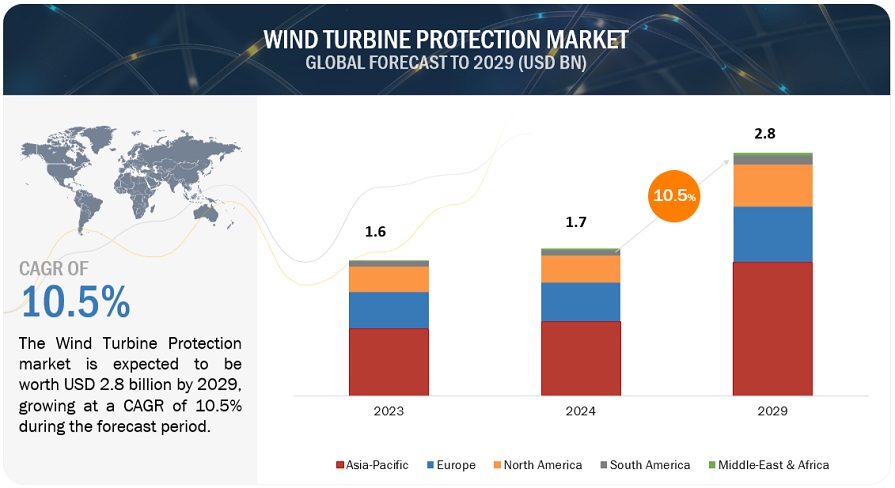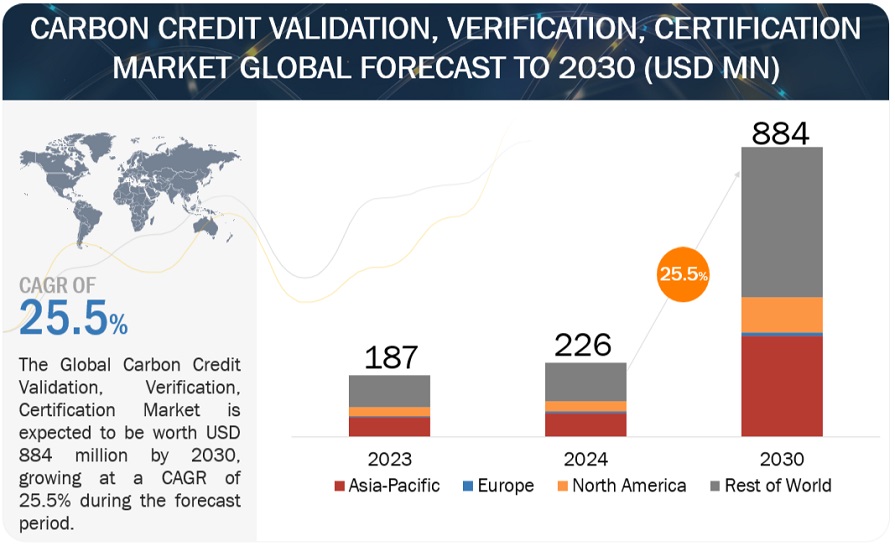According to a research report "Wind Turbine Protection Market by Equipment (Blades, Nacelles, Towers), Protection Type (Coatings (Epoxy, Polyurethane) and Tapes & Films), End User (Onshore and Offshore), & Region (North America, Europe, APAC, MEA) - Global Forecast to 2029" published by MarketsandMarkets, the Wind turbine protection market is forecast to reach USD 2.8 billion by 2029 from an estimated USD 1.7 billion in 2024, at a CAGR of 10.5% during the forecast period (2024-2029).

Wind turbine protection is essential because they face numerous environmental challenges, including rain, hail, blowing sand, and salt spray, which can cause significant leading-edge erosion on the blades. This erosion can be severely affecting the integrity and efficiency of the blades. wind turbine protection is essential to safeguard the blades, nacelle, and internal components, maintain aerodynamic efficiency, prevent damage and downtime, and extend the operational lifespans of wind turbines.
Download PDF Brochure: https://www.marketsandmarkets.com/pdfdownloadNew.asp?id=101493518
The Nacelle, by equipment, is expected to grow as the Second largest segment during the forecast period.
Based on equipment, the wind turbine protection market has been split into Nacelle, Blades, Tower and others. The Nacelle segment in the wind turbine protection market is anticipated to be the second largest because the nacelle, houses critical components like the generator and gearbox which demands robust protection against weather elements and thermal stress to maintain operational integrity. The nacelle is a vital component that protects the turbine machinery, enables safe maintenance, optimizes airflow, and withstands wind forces.
Onshore, by End user, is expected to grow as the largest segment during the forecast period.
Based on End user, the wind turbine protection market has been split into Onshore and Offshore. The Onshore segment in the wind turbine protection market is anticipated to be the largest because the onshore wind farms are generally less expensive compared to offshore projects. The onshore segment experienced rapid growth because of the cost advantages, technological advancements and better infrastructure.
Coatings, by protection type, are expected to grow as the largest segment during the forecast period.
This report segments the wind turbine protection market based on offering into Various protection types: Coatings, Tapes & Films. The coatings segment in the wind turbine protection market is anticipated to be the largest because the coatings include protection against corrosion, particularly in harsh offshore environments, and resistance to erosion caused by rain, sand, and dust, which is vital for maintaining the aerodynamic efficiency of the blades. The benefits of applying these coatings are extended the operational lifespan of wind turbines by preventing corrosion and wear, which in turn reduces the frequency and costs associated with maintenance.
Europe is expected to be the Second largest region in the wind turbine protection market
Europe is expected to be the Second largest region in the wind turbine protection market during the forecast period. The region's increasing focus on wind turbine protection is due to the presence of major wind turbine manufacturers, including Vestas, Siemens Gamesa, and Nordex. Europe is leading the global expansion of offshore wind, with countries like the UK, Germany, and the Netherlands investing heavily in offshore wind projects.
Request Sample Pages: https://www.marketsandmarkets.com/requestsampleNew.asp?id=101493518
Some of the major players in the wind turbine protection market are BASF SE (Germany), 3M (US), Akzo Nobel N.V. (Netherlands), Trelleborg AB (Sweden), Hempel A/S (Denmark). The major strategies adopted by these players include sales contracts, product launches, investments, collaborations, partnerships, and expansions.
About MarketsandMarkets™
MarketsandMarkets™ has been recognized as one of America’s best management consulting firms by Forbes, as per their recent report.
MarketsandMarkets™ is a blue ocean alternative in growth consulting and program management, leveraging a man-machine offering to drive supernormal growth for progressive organizations in the B2B space. We have the widest lens on emerging technologies, making us proficient in co-creating supernormal growth for clients.
Earlier this year, we made a formal transformation into one of America's best management consulting firms as per a survey conducted by Forbes.
The B2B economy is witnessing the emergence of $25 trillion of new revenue streams that are substituting existing revenue streams in this decade alone. We work with clients on growth programs, helping them monetize this $25 trillion opportunity through our service lines - TAM Expansion, Go-to-Market (GTM) Strategy to Execution, Market Share Gain, Account Enablement, and Thought Leadership Marketing.
Built on the 'GIVE Growth' principle, we work with several Forbes Global 2000 B2B companies - helping them stay relevant in a disruptive ecosystem. Our insights and strategies are molded by our industry experts, cutting-edge AI-powered Market Intelligence Cloud, and years of research. The KnowledgeStore™ (our Market Intelligence Cloud) integrates our research, facilitates an analysis of interconnections through a set of applications, helping clients look at the entire ecosystem and understand the revenue shifts happening in their industry.
Contact:
Mr. Rohan Salgarkar
MarketsandMarkets™ INC.
630 Dundee Road
Suite 430
Northbrook, IL 60062
USA: +1-888-600-6441
Email: newsletter@marketsandmarkets.com
